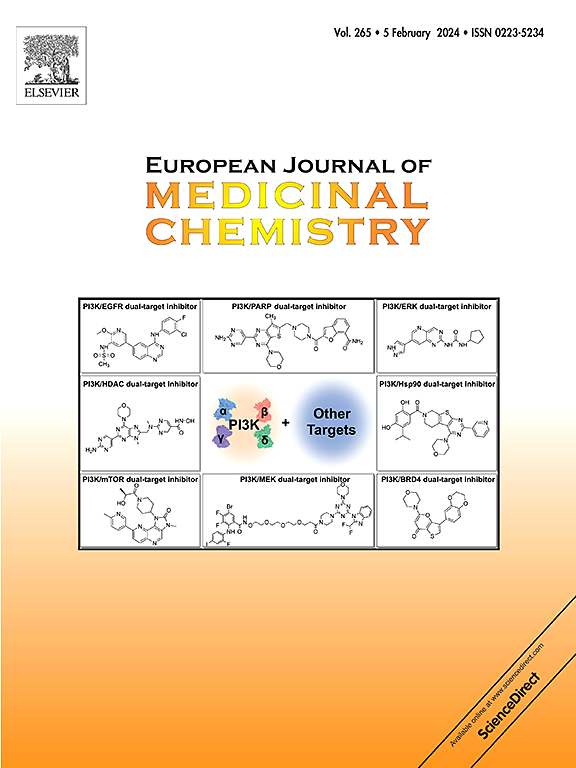Optimization of an Hsp90β-selective inhibitor via exploration of the Hsp90 N-terminal ATP-binding pocket
IF 5.9
2区 医学
Q1 CHEMISTRY, MEDICINAL
引用次数: 0
Abstract
The 90-kDa heat shock protein (Hsp90) promotes the maturation of >400 client protein substrates, many of which are implicated in the development/progression of cancer. Although 22 Hsp90 N-terminal inhibitors have undergone clinical evaluation, the toxicities that arose from pan-inhibition have hindered their development as chemotherapeutic agents. Hence, Hsp90 isoform-selective inhibition represents a promising alternative to overcome these detriments. We recently described the structure-based design of an isoquinolin-1(2H)-one-containing scaffold and produced several highly potent Hsp90β-selective inhibitors, such as KUNB106. But there are limitations to these compounds that require further optimization. Herein, we describe structure-activity relationship (SAR) studies on the KUNB106 indazolone ring system to assess the structural limits of Hsp90β binding. Among the alterations explored in this work, alkyl chain homologation, fluorination, and spirocyclization were most effective at retaining high affinity and selectivity towards Hsp90β. Subsequent biological characterization revealed these derivatives to promote the degradation of Hsp90β-dependent clients while avoiding the induction of Hsp90 levels, which is consistent with prior studies. Altogether, the work presented in this study supports the therapeutic advantages of Hsp90β-selective inhibition over Hsp90 pan-inhibition.


通过探索Hsp90 n端atp结合口袋优化Hsp90β选择性抑制剂
90千道尔顿热休克蛋白(Hsp90)促进400种客户蛋白底物的成熟,其中许多与癌症的发生/进展有关。尽管22种Hsp90 n端抑制剂已经进行了临床评估,但泛抑制产生的毒性阻碍了它们作为化疗药物的发展。因此,Hsp90异构体选择性抑制是克服这些损害的一种有希望的替代方法。我们最近描述了一种基于结构的含有异喹啉-1(2H)- 1的支架设计,并生产了几种高效的hsp90 β选择性抑制剂,如KUNB106。但这些化合物也有局限性,需要进一步优化。本文通过对KUNB106吲达唑酮环体系的构效关系(SAR)研究来评估Hsp90β结合的结构极限。在这项研究中,烷基链同源化、氟化和螺旋环化对Hsp90β保持高亲和力和选择性是最有效的。随后的生物学表征表明,这些衍生物可以促进Hsp90β依赖性客户的降解,同时避免诱导Hsp90水平,这与先前的研究一致。总之,本研究中提出的工作支持Hsp90β选择性抑制优于Hsp90泛抑制的治疗优势。
本文章由计算机程序翻译,如有差异,请以英文原文为准。
求助全文
约1分钟内获得全文
求助全文
来源期刊
CiteScore
11.70
自引率
9.00%
发文量
863
审稿时长
29 days
期刊介绍:
The European Journal of Medicinal Chemistry is a global journal that publishes studies on all aspects of medicinal chemistry. It provides a medium for publication of original papers and also welcomes critical review papers.
A typical paper would report on the organic synthesis, characterization and pharmacological evaluation of compounds. Other topics of interest are drug design, QSAR, molecular modeling, drug-receptor interactions, molecular aspects of drug metabolism, prodrug synthesis and drug targeting. The journal expects manuscripts to present the rational for a study, provide insight into the design of compounds or understanding of mechanism, or clarify the targets.

 求助内容:
求助内容: 应助结果提醒方式:
应助结果提醒方式:


